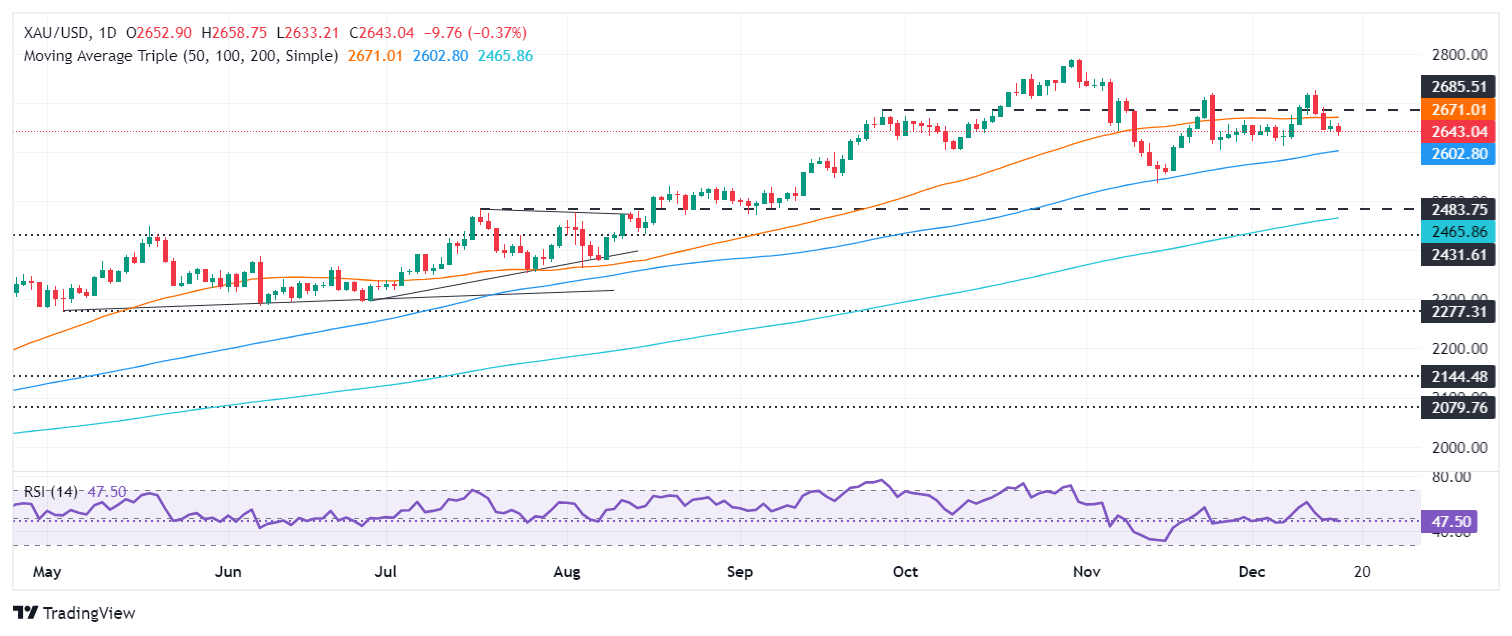
- Gold price refreshes new weekly low following strong US Retail Sales figures that dim expectations for aggressive Fed easing next year.
- Despite a drop in Treasury yields, a resilient US Dollar limits Gold’s upward momentum.
- Investors eye the Fed’s policy announcement and the core PCE Price Index release.
Gold price dropped to a new weekly low of $2,633 on Tuesday following the release of strong Retail Sales data in the United States. This weighed on investors’ expectations of the Federal Reserve (Fed), which is expected to adopt a gradual approach to easing in 2025. At the time of writing, the XAU/USD trades at $2,637, down 0.57%.
The Fed has begun its two-day meeting in Washington, DC, and is expected to lower interest rates by 25 basis points (bps) on Wednesday. The markets have already priced in the decision, but participants are looking for the Summary of Economic Projections (SEP) and the Dot Plot. This will provide investors with the Fed rate path for 2025.
The US economic docket witnessed a strong Retail Sales report in November. Later, the Fed announced that Industrial Production for the same period plunged in monthly and annual figures, an indication that business activity continued to suffer from higher interest rates.
Bullion prices remain pressured even though US Treasury bond yields and real yields retreated. Nevertheless, the steady US Dollar keeps the non-yielding metal from extending its gains.
Lower interest rates the Fed sets are usually a tailwind for Gold prices. Speculation that Trump’s upcoming administration would implement expansionary fiscal policies that put upward pressure on inflation could trigger a change among the Federal Open Market Committee (FOMC) members.
Ahead this week, the US economic docket will feature the FOMC policy decision and the release of the core Personal Consumption Expenditures (PCE) Price Index.
Daily digest market movers: Gold price slips below $2,650, extends losses
- Gold prices plunged as US real yields are pressured, falling two basis points to 2.059%, a tailwind for the precious metal.
- The US 10-year Treasury bond yield drops two and a half basis points to 4.379%.
- The US Dollar Index rose 0.07% to 107.01.
- US Retail Sales in November rose by 0.7% MoM, up from 0.5% in October, above estimates. Yearly, sales jumped from 2.9% to 3.8%.
- Industrial Production in November improved compared to October yet dipped to -0.1% MoM, up from -0.4% and below estimates of 0.3%
- US business activity remains robust in the services segment, according to S&P Global.
- The CME FedWatch Tool suggests that traders had priced in a 99% chance of a quarter-point rate cut on Wednesday.
- For 2025, investors are betting that the Fed will lower rates by 100 basis points.
Technical outlook: Gold price retreats, sellers eye 100-day SMA
Gold uptrend remains intact, yet in the near term it is slightly skewed to the downside. The golden metal has been accepted within the $2,602-$2,670 area, capped by the 100 and 50-day Simple Moving Averages (SMAs), respectively.
If Gold drops below the 100-day SMA, the next support would be $2,600. If the price slips, the next support would be the November 14 swing low of $2,536, before challenging the August 20 peak at $2,531. Conversely, if XAU/USD rallies past $2,650, the next resistance would be the 50-day SMA at $2,670, ahead of $2,700.
Economic Indicator
Fed Interest Rate Decision
The Federal Reserve (Fed) deliberates on monetary policy and makes a decision on interest rates at eight pre-scheduled meetings per year. It has two mandates: to keep inflation at 2%, and to maintain full employment. Its main tool for achieving this is by setting interest rates – both at which it lends to banks and banks lend to each other. If it decides to hike rates, the US Dollar (USD) tends to strengthen as it attracts more foreign capital inflows. If it cuts rates, it tends to weaken the USD as capital drains out to countries offering higher returns. If rates are left unchanged, attention turns to the tone of the Federal Open Market Committee (FOMC) statement, and whether it is hawkish (expectant of higher future interest rates), or dovish (expectant of lower future rates).
Next release: Wed Dec 18, 2024 19:00
Frequency: Irregular
Consensus: 4.5%
Previous: 4.75%
Source: Federal Reserve


